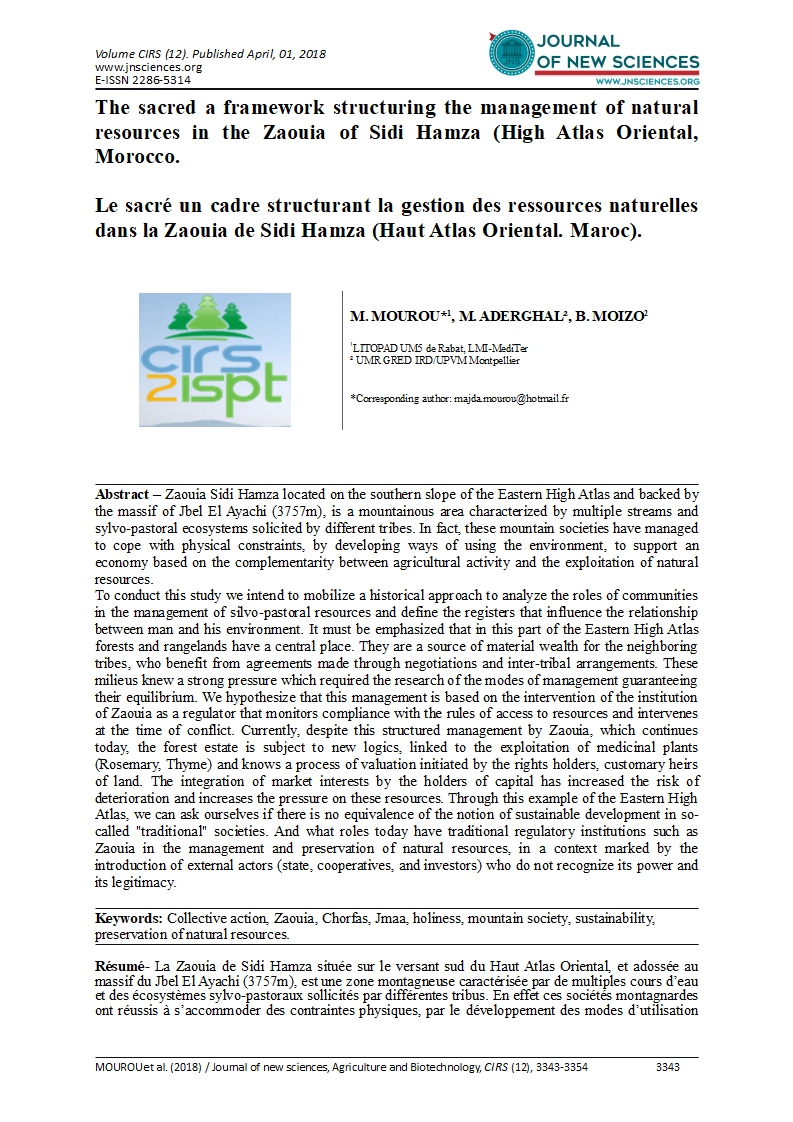

- Category: VOLUME SPÉCIAL (CONFÉRENCE CIRS 2017)
- Hits: 7860
The sacred a framework structuring the management of natural resources in the Zaouia of Sidi Hamza (High Atlas Oriental, Morocco.
Le sacré un cadre structurant la gestion des ressources naturelles dans la Zaouia de Sidi Hamza (Haut Atlas Oriental. Maroc).
|
|
M. MOUROU*1 M. ADERGHAL² B. MOIZO2
1LITOPAD UM5 de Rabat, LMI-MediTer ² UMR GRED IRD/UPVM Montpellier |
Abstract – Zaouia Sidi Hamza located on the southern slope of the Eastern High Atlas and backed by the massif of Jbel El Ayachi (3757m), is a mountainous area characterized by multiple streams and sylvo-pastoral ecosystems solicited by different tribes. In fact, these mountain societies have managed to cope with physical constraints, by developing ways of using the environment, to support an economy based on the complementarity between agricultural activity and the exploitation of natural resources. To conduct this study we intend to mobilize a historical approach to analyze the roles of communities in the management of silvo-pastoral resources and define the registers that influence the relationship between man and his environment. It must be emphasized that in this part of the Eastern High Atlas forests and rangelands have a central place. They are a source of material wealth for the neighboring tribes, who benefit from agreements made through negotiations and inter-tribal arrangements. These milieus knew a strong pressure which required the research of the modes of management guaranteeing their equilibrium. We hypothesize that this management is based on the intervention of the institution of Zaouia as a regulator that monitors compliance with the rules of access to resources and intervenes at the time of conflict. Currently, despite this structured management by Zaouia, which continues today, the forest estate is subject to new logics, linked to the exploitation of medicinal plants (Rosemary, Thyme) and knows a process of valuation initiated by the rights holders, customary heirs of land. The integration of market interests by the holders of capital has increased the risk of deterioration and increases the pressure on these resources. Through this example of the Eastern High Atlas, we can ask ourselves if there is no equivalence of the notion of sustainable development in so-called "traditional" societies. And what roles today have traditional regulatory institutions such as Zaouia in the management and preservation of natural resources, in a context marked by the introduction of external actors (state, cooperatives, and investors) who do not recognize its power and its legitimacy.
Keywords: Collective action, Zaouia, Chorfas, Jmaa, holiness, mountain society, sustainability, preservation of natural resources.
Résumé- La Zaouia de Sidi Hamza située sur le versant sud du Haut Atlas Oriental, et adossée au massif du Jbel El Ayachi (3757m), est une zone montagneuse caractérisée par de multiples cours d’eau et des écosystèmes sylvo-pastoraux sollicités par différentes tribus. En effet ces sociétés montagnardes ont réussis à s’accommoder des contraintes physiques, par le développement des modes d’utilisation du milieu, permettant de soutenir une économie basée sur la complémentarité entre l’activité agricole et l’exploitation des ressources naturelles. Pour mener cette étude nous comptons mobiliser une approche historique afin d’analyser les rôles des communautés dans la gestion des ressources sylvo-pastorales et définir les registres qui influencent les rapports entre l’homme et son environnement. Il faut souligner que dans cette partie du Haut Atlas Oriental les forêts et les parcours ont une place centrale. Ils constituent une source de richesse matérielle pour les tribus avoisinantes, qui tirent bénéfice des accords menés à travers les négociations et les arrangements intertribaux. Ces milieux connaissaient une forte pression qui supposait la recherche des modes de gestion garantissant leuréquilibre. Nous posons l’hypothèse que cette gestion s’appuie sur l’intervention de l’institution de la Zaouia comme acteur régulateur qui veille sur le respect des règles d’accès aux ressources et intervient au moment des conflits. Actuellement malgré cette gestion structurée par la Zaouia qui se poursuit aujourd’hui, le domaine forestier est soumis à de nouvelles logiques, liées à l’exploitation des plantes médicinales (Romarin, Thym) et connaissent un processus de valorisation initié par les ayants droits, héritiers coutumiers des terres. L’intégration des intérêts marchands par les porteurs des capitaux a augmenté le risque de dégradation et multiplie la pression sur ces ressources. A travers cet exemple du Haut Atlas Oriental, nous pouvons nous demander s’il n y’a pas d’équivalence de la notion de développement durable chez les sociétés dites « traditionnelles » ? Et quels rôles aujourd’hui ont les institutions traditionnelles de régulation telle que la Zaouia dans la gestion et la préservation des ressources naturelles, dans un contexte marqué par l’introduction des acteurs externes (état, coopératives, investisseurs) qui ne reconnaissent pas son pouvoir et sa légitimité.
Mots clés :Action collective, Zaouia, Chorfas, Jmaa, sainteté, société montagnarde, durabilité, préservation des ressources naturelles
-
Introduction
